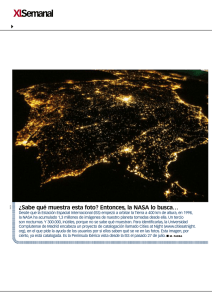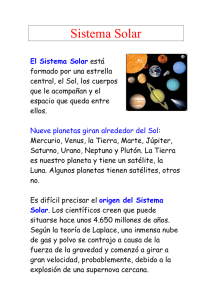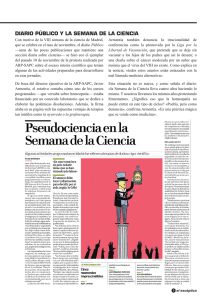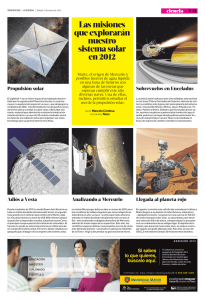E LHE - Trasmediterranea
Anuncio
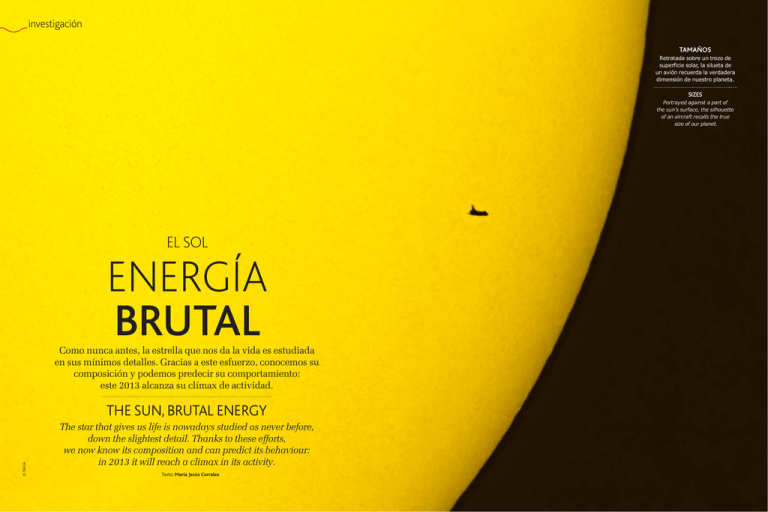
bgo^lmb`Z\bg
TAMAÑOS
C+1-212/2(),=-+(*5(1-,D,(/+(
VXSHU¿FLHVRODUODVLOXHWDGH
XQDYLyQUHFXHUGDODYHUGDGHUD
GLPHQVLyQGHQXHVWURSODQHWD
SIZES
;*%.%(4#&$(2(0)'.$($6(%.$*+$
."#$'-)<'$'-%+(9#1$."#$'0/"*-#..#$
*+$()$(0%9%(+.$%#9(//'$."#$.%-#
$'0=#$*+$*-%$6/()#.:$
>ELHE
>G>K@×:
BRUTAL
"#$#%&'&()%)&*+,-%.)%+,*/+..)%0'+%&#,%1)%.)%231)%+,%+,*'13)1)%
+&%,',%$4&3$#,%1+*)..+,!%5/)(3),%)%+,*+%+,6'+/7#-%(#&#(+$#,%,'%
(#$8#,3(39&%:%8#1+$#,%8/+1+(3/%,'%(#$8#/*)$3+&*#;%
+,*+%<=>?%).()&7)%,'%(.4$)@%1+%)(*3231)1!
© NASA
THE SUN, BRUTAL ENERGY
!"#$%&'($&"'&$)*+#%$,%$-*.#$*%$/01'2'3%$%&,2*#2$'%$/#+#($4#.0(#5$
201/$&"#$%-*)"&#%&$2#&'*-6$!"'/7%$&0$&"#%#$#..0(&%5$
1#$/01$7/01$*&%$809:0%*&*0/$'/2$8'/$:(#2*8&$*&%$4#"'+*0,(;$
*/$<=>?$*&$1*--$(#'8"$'$8-*9'@$*/$*&%$'8&*+*&36
Texto: María Jesús Corrales
AA
portada
investigación
© Fotos: NASA
El espectáculo de
las auroras pinta
con insólitos
colores los cielos
polares
El impacto de las
partículas solares
contra la atmósfera
origina las auroras
boreales. The
impact of solar
particles against our
atmosphere causes
the phenomenon of
the aurora borealis.
!"
Cuentan en Finlandia que cuando el zorro
ártico roza con su cola las montañas provoca chispas que se convierten en luces en el
cielo y forman las auroras boreales. El relato
es bonito. La realidad es distinta. Más prosaica, indica que el maravilloso espectáculo se
debe al impacto de partículas de masa solar contra el campo magnético de la Tierra.
Los protones y electrones expulsados por
el Sol a más de mil kilómetros por segundo
chocan con el oxígeno y el nitrógeno de la
atmósfera y liberan la energía que vemos
en los destellos. Y eso ocurre porque nuestra
estrella está muy viva.
Aunque a simple vista parezca que el Sol
siempre da la misma energía, no es así. En
su superficie hay manchas, que son zonas
más frías que el resto de la fotosfera, donde
las tensiones del campo magnético provocan con el tiempo grandes turbulencias que
finalmente estallan en fulguraciones y “disparos” de partículas, llamados erupciones de
masa coronal (CME), que suelen alcanzar la
Tierra en un plazo de entre uno y tres días.
Javier Armentia, Director del Planetario de
Pamplona, explica que “las manchas solares
se forman porque el material caliente que
hay en el interior del Sol sale hacia afue-
ra. En la fotosfera, los campos magnéticos
atrapan ese gas, que es hidrógeno a 4.000
grados, hacen que no suba y esas zonas se
quedan más oscuras. Pero además, la interacción produce tal liberación de energía
que es capaz de calentar gas a millones de
grados y lanzarlo al Sistema Solar, tanto en
forma de destellos como de partículas que
alteran la envoltura magnética de la Tierra”.
Un ciclo completo de aparición y desaparición de manchas dura once años, y en este
momento, la estrella que nos ilumina se halla en el período de máxima actividad. El Sol
empezó a despertar en agosto y se prevé
que alcance su clímax en este año 2013.
Como explican en la Nasa, cuando esas
partículas impactan en la magnetosfera, el
campo magnético terrestre, pueden desencadenar un fenómeno llamado tormenta
geomagnética. Y si bien la atmósfera nos
protege bastante de sus efectos, las grandes
tormentas son capaces de provocar disfunciones en los sistemas eléctricos de la Tierra,
interferir los GPS, los sistemas de comunicación por satélite o las redes eléctricas
inteligentes, lo cual complicaría los viajes
en avión o la actividad financiera. “Curiosamente”, dice Armentia, “este máximo de
In Finland, so the story goes, when an arctic
fox brushes its tail against the mountain tops,
it gives off sparks that turn into lights in the
night sky and form the Northern Lights or aurora borealis. It is a lovely story but reality is
different. More prosaically, science shows that
the wonderful spectacle is due to the impact
of solar mass particles against the Earth’s
magnetic field. The protons and electrons
driven off by the Sun at speeds of more than
a thousand kilometres per second collide with
the oxygen and nitrogen in the atmosphere
and release the energy we see in those flashing lights. And that happens because our star
is very much alive.
Although the Sun may seem, at first sight, to
be giving off the same energy all the time,
that is not the case. There are spots on the
sun’s surface, areas that are colder than the
rest of the photosphere, where the tensions
in the magnetic field cause, over time, a tremendous turbulence that is finally released in
the form of solar flares or brightening called
“coronal mass ejections” (CME), which normally reach Earth within two or three days.
Javier Armentia, Director of the Pamplona
Planetarium, explains that “solar flares are
formed because the hot material inside the
Sun’s core comes out. The magnetic fields
trap that gas, made up of hydrogen at 4,000
degrees Kelvin, in the photosphere, which
means that it doesn’t rise up and those areas remain darker. In addition, this interaction
causes such a release of energy that the gas
can be heated to temperatures of millions of
degrees and expelled into the solar system
in the form of both flares and particles that
can alter the Earth’s magnetic envelope”.
AL CALOR DE LAS CIFRAS
FIGURES TO WARM YOUR HEART
15 millones de grados centígrados.
Es la temperatura en el interior de la estrella.
El Sol libera
5 millones de toneladas 15 million degrees Celsius.
de energía pura por segundo.
The temperature in the core
760.000
Es decir,
veces la producción energética mundial.
3,85 millones de
exajulios son absorbidos al año por la
atmósfera, los océanos y los continentes.
exajulio equivale a
170 millonesdeUnbarriles
de petróleo.
5 million tonnes
The Sun releases
of pure energy per second.
760,000
times he world’s energy production.
3.85 million exajoules are
absorved by the atmosphere, the oceans
and the continents every year.
An exajoule is equivalent to
170 million barrels of oil.
!"
investigación
entrevista
SEIS CAPAS ARDIENTES Y GASEOSAS
SIX LAYERS OF HOT GASES
#$%&'$%()%*+,%-'$,%.,)('),%/(%0,1,)%0'+02+3450,)6%
&*%()34*03*4,%785/49.(+'%(+%*+%:;<=%()%()3,>
?8(%&*+%5)%,%.,)('*)%-,$$%@,/(%*1%'A%0'+0(+3450%
$,B(4)6%C3)%)34*03*4(%7:;<%8B/4'.(+=%0'+)5)3)%'A>
NÚCLEO CORE
D'+,%/(%,$3,)%3(@1(4,3*4,)%(+%$,%E*(%)(%14'/*0(%
$,%A*)59+%+*0$(,4%B%)(%.(+(4,%$,%(+(4.F,6%?8(%,4(,%
G538%38(%85.8()3%3(@1(4,3*4()%5+%G8508%+*0$(,4%
A*)5'+%3,H()%1$,0(%,+/%38(%(+(4.B%5)%.(+(4,3(/6
ZONA RADIACTIVA RADIOACTIVE AREA
I'+/(%$')%A'3'+()%E*(%34,+)1'43,+%$,%(+(4.F,%
5+3(+3,+%()0,1,4%,$%(J3(45'46%&*%K5,L(%/*4,%
M;;6;;;%,N')6%O8(4(%38(%18'3'+)%34,+)1'435+.%
38(%(+(4.B%,4(%34B5+.%3'%()0,1(%5+3'%38(%
'*3)5/(6%?8(54%L'*4+(B%$,)3)%A'4%M;;P;;;%B(,4)6
© Fotos: NASA
ZONA CONVECTIVA CONVECTIVE AREA
QE*FP%$,)%0'$*@+,)%/(%.,)%0,$5(+3(%,)05(+/(+%
8,)3,%$,%)*1(4!%05(P%)(%(+A4F,+%B%K*($K(+%,%
/()0(+/(46%R(4(%38(%0'$*@+)%'A%8'3%.,)%0$5@-%
3'%38(%)*4A,0(P%0''$%/'G+%,+/%/()0(+/%,.,5+6%
FOTOSFERA PHOTOSPHERE
#)%$,%0,1,%(J3(45'4P%$,%E*(%K(@')6%?5(+(%*+,%
3(@1(4,3*4,%/(%S6;;;%TU%0'+%V'+,)%@W)%A4F,)P%
$,)%@,+08,)%)'$,4()P%/(%X6;;;%TU6%?85)%5)%38(%
'*3(4%$,B(4P%38(%'+(%G(%0,+%)((6%C3)%3(@1(4,3*4(%
5)%,4'*+/%SP;;;TU%G538%)'@(%0''$(4%,4(,)P%38(%
)*+)1'3)P%,3%XP;;;TU6
La energía solar que
llega cada año a la
Tierra duplica toda
la energía jamás
producida por otros
medios. The amount
of solar energy
reaching the Earth
each year is twice
as much as all the
energy ever produced
by all other means.
!"
actividad solar es un 30% menor que hace
12 años, pero nos asusta más por nuestra
mayor dependencia de la electricidad”. La
tormenta solar más potente registrada, “la
fulguración de Carrington”, ocurrió en 1859.
Aquel año se observaron auroras boreales
incluso en el Caribe.
Por suerte, hoy se cuenta con una ingente
información de lo que le pasa al Sol y numerosos laboratorios científicos se ocupan
de observarlo cada segundo. Por ejemplo, el
Centro de Predicción del Tiempo Espacial de
la Administración Atmosférica de Estados
Unidos, en Boulder, Colorado. “La previsión
A complete solar cycle of sunspots appearing and disappearing lasts for eleven years
and, at this moment, the star lighting our
world is in the period of maximum activity.
The Sun started waking up in August and is
expected to reach its climax in 2013.
The way they explain it at NASA is that
when these particles impact on the magnetosphere, the Earth’s magnetic wrapper, as it
were, they may trigger a phenomenon called
a geomagnetic storm. While the atmosphere
is able to protect us quite well against the
effects of these storms, the largest ones are
capable of triggering dysfunctions in electri-
CROMOSFERA CHROMOSPHERE
&'$'%1*(/(%K(4)(%/*4,+3(%*+%(0$51)(%)'$,46%
Y'L5V,P%/(%/(+)5/,/%@*B%-,L,%B%Z;;6;;;%TU%
/(%3(@1(4,3*4,P%()3W%A'4@,/,%1'4%.,)()%
(+4,4(05/')6%?85)%0,+%'+$B%-(%)((+%/*45+.%
,%)'$,4%(0$51)(6%C3%5)%4(//5)8P%G538%K(4B%$'G%
/(+)53BP%,%3(@1(4,3*4(%'A%Z;;P;;;TU%,+/%5)%
@,/(%*1%'A%4,4(!%(/%.,)()6
CORONA CORONA
U,1,%/(%.4,+%(J3(+)59+P%,$3,)%3(@1(4,3*4,)%
B%-,LF)5@,%/(+)5/,/6%&*)%.,)()%B%($%0,@1'%
@,.+2350'%K,4F,+%)*%A'4@,%/(%8'4,%(+%8'4,6%
Q%$,B(4%G538%,%8*.(%(J3(+)5'+P%K(4B%85.8%
3(@1(4,3*4()%,+/%(J34(@($B%$'G%/(+)53B6%C3)%
.,)()%,+/%@,.+(350%!%($/%"%*03*,3(%-B%38(%8'*46
!"
investigación
Una inocultable
fábrica de luz y
energía que llega
incluso hasta el
fondo de mar
del tiempo espacial [como el meteorológico,
pero en el espacio] está todavía en la infancia, aunque estamos progresando rápido”,
dice a la Nasa Thomas Bogdan, su director.
Pero, ¿cómo podemos saber con tanta precisión qué pasa en nuestra estrella? “Porque
el Sol está cerca, se ve grande y nos manda
mucha luz”, explica Armentia. “Esa luz se
descompone gracias a filtros de distintos
colores, y se seleccionan longitudes de onda
muy concretas que nos hablan de cómo se
comporta el gas que lo forma”. Esto, y toda
una batería de sensores, cronógrafos y radiotelescopios que lo enfocan y analizan.
Además de varios satélites, como los dos que
componen el observatorio STEREO, el ACE y
el SDO, todos de la Nasa; el SOHO, misión
conjunta entre la agencia norteamericana y
la europea ESA; y el Sunrise, colaboración entre la Nasa, los alemanes de la DLR y nuestro
español Programa Nacional de Espacio.
La actividad que alberga la estrella de
nuestro sistema es impresionante. “El Sol
es energía para la vida”, señala Armentia,
“una auténtica alternativa por encima de
los combustibles fósiles, que increíblemente aún no se ha desarrollado lo suficiente”.
Por fortuna, se estima que seguirá quemando hidrógeno de forma estable otros 5.000
millones de años. Contamos con todo ese
tiempo para aprovecharlo.
© NASA
Las dos capas más
externas del Sol,
la cromosfera y la
corona, solo son
visibles durante la
fase de totalidad
de un eclipse.
The Sun’s two
outermost layers,
the chromosphere
and the corona, are
only visible during
the totality phase
of a solar eclipse.
!"
cal systems on Earth, interfere with GPS devices, satellite communications systems or
smart power grids, which would complicate
air travel or financial dealings. “Curiously”,
say Armentia, “this peak in solar activity is
30% less than the last time 12 years ago,
but it’s even more terrifying now because
we have become more dependent on electricity”. The most powerful solar storm ever
recorded, “Carrington’s flare”, occurred in
1859. That year, the aurora borealis could be
seen even in the Caribbean.
Luckily, nowadays we have a huge amount
of data on what is happening to the Sun
and numerous scientific laboratories are
engaged in observing it round the clock,
for example, the Space Weather Prediction Centre in Boulder, Colorado, part of
the National Oceanic and Atmospheric Administration in the United States. “Space
weather predictions [just like our everyday weather forecasts but for outer space]
are still in their early days, although we are
making steady progress”, its Director, Thomas Bogdan, tells NASA.
But how can we know so accurately what
is happening on the surface of our star?
“Because the Sun is close, it looks very large
and sends us a lot of light”, Armentia explains. “That light can be broken down using
different-coloured filters, and very specific
wavelengths can be selected to tell us more
about how the component gas is behaving”.
That plus a whole battery of sensors, chronographs and radiotelescopes examining and
analysing the sun.
In addition to several satellites, such as the
two making up the STEREO observatory, ACE
and SDO, all belonging to NASA; the SOHO
joint mission between the US and European
space agencies; and the Sunrise, a collaboration between NASA, the Germans in the DLR
and Spain’s National Space Programme.
The amount of activity going on in our system’s star is impressive. “The Sun is energy
for life”, says Armentia, “a true alternative
over and above fossil fuels, yet it has, incredibly, still not been sufficiently developed”.
Fortunately, it has been estimated that it
will go on steadily burning hydrogen for another 5 billion years. We have all that time in
which to harness it.
